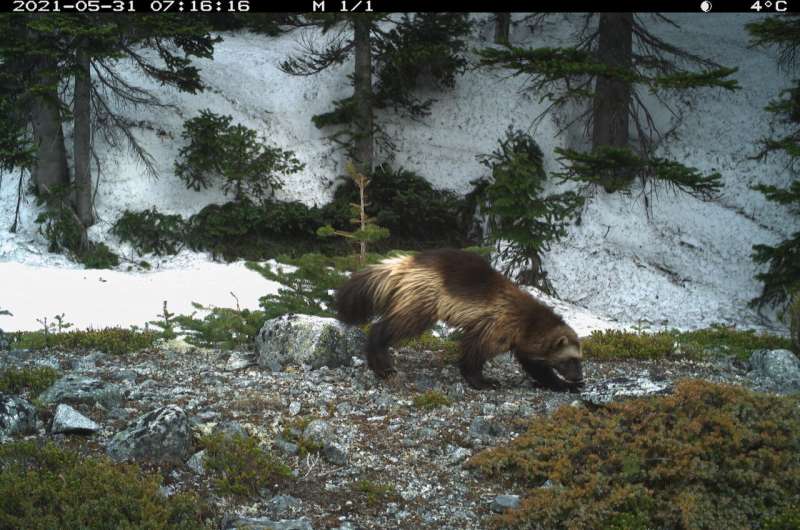
One of the largest studies on wildlife activity—involving more than 220 researchers, 163 mammal species and 5,000 camera traps worldwide—reveals that wild animals react differently to humans depending on where the animals live and what they eat. The study was published in Nature Ecology & Evolution.
Bigger herbivores—plant-eating animals like deer or moose—tend to become more active when humans are around, while meat-eaters like wolves or wolverines tend to be less active, preferring to avoid risky encounters.
Urban animals like deer or raccoons may become more active around people, as they get used to human presence and find food like garbage or plants, which they can access at night. But animals living farther from cities and other developed areas are more wary of encountering people.
Wildlife during the pandemic ‘anthropause’
The new study, a collaboration across researchers from 161 institutions, used data from before and during the COVID-19 lockdowns to examine wildlife behavior amid changing human activity levels.
“COVID-19 mobility restrictions gave researchers a truly unique opportunity to study how animals responded when the number of people sharing their landscape changed drastically over a relatively short period,” said lead author Dr. Cole Burton, an associate professor of forest resources management at UBC and Canada Research Chair in Terrestrial Mammal Conservation.
“And contrary to the popular narratives that emerged around that time, we did not see an overall pattern of ‘wildlife running free’ while humans sheltered in place. Rather, we saw great variation in activity patterns of people and wildlife, with the most striking trends being that animal responses depended on landscape conditions and their position in the food chain.”
In Canada, researchers monitoring areas such as Banff and Pacific Rim national parks, Cathedral, Golden Ears and South Chilcotin Mountains provincial parks, and the Sea-to-Sky corridor in B.C. found that carnivores like wolverines, wolves and cougars were generally less active when human activity was higher.
In several of these parks, and in cities such as Edmonton, large herbivores often increased their activity but became more nocturnal with the presence of more humans. Large carnivores were notably absent from the most human-dominated landscapes.

Preventing conflict through smart conservation measures
These findings highlight the importance of measures to minimize any detrimental effects of human disturbance on wildlife, including reducing overlaps that might lead to conflict.
“In remote areas with limited human infrastructure, the effects of our actual presence on wildlife may be particularly strong. To give wild animals the space they need, we may consider setting aside protected areas or movement corridors free of human activity, or consider seasonal restrictions, like temporary closures of campsites or hiking trails during migratory or breeding seasons,” said study co-author and UBC biologist Dr. Kaitlyn Gaynor.
She added that strategies must also fit specific species and locations. In more remote areas, keeping human activity low will be necessary to protect sensitive species. In areas where people and animals overlap more, such as cities, nighttime is an important refuge for wildlife, and keeping it that way can help species survive.
Efforts may focus on reducing human-wildlife conflict after dark, such as more secure storage of trash bins to reduce the number of animals getting into human food sources, or use of road mitigation measures to reduce vehicle collisions.
The findings are particularly useful amid the surge in global travel and outdoor recreation post-pandemic, Dr. Burton added.
“Understanding how wildlife respond to human activity in various contexts helps us develop effective conservation plans that have local and global impact. For that reason, we are working to improve wildlife monitoring systems using tools like the camera traps that made it possible to observe animal behaviors during the pandemic.”
More information:
Cole Burton, Mammal responses to global changes in human activity vary by trophic group and landscape, Nature Ecology & Evolution (2024). DOI: 10.1038/s41559-024-02363-2. www.nature.com/articles/s41559-024-02363-2
Provided by
University of British Columbia
Citation:
Global wildlife study during COVID-19 shows rural animals are more sensitive to human activity (2024, March 18)
retrieved 18 March 2024
from https://phys.org/news/2024-03-global-wildlife-covid-rural-animals.html
This document is subject to copyright. Apart from any fair dealing for the purpose of private study or research, no
part may be reproduced without the written permission. The content is provided for information purposes only.
